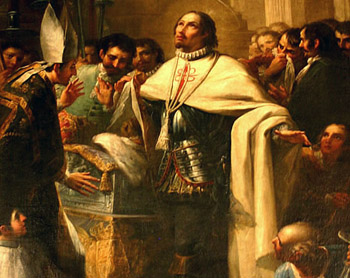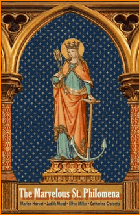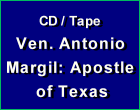Stories & Legends
 |
 |
 |
 |
 |
 |
 |
The Conversion of the Duke of Gandia
Francis de Borja
Here, in Granada, a stone cross recalls the last journey of the Empress Isabella who died in Toledo on May 1, 1539. The Emperor Charles V withdrew to the Hieronymites' monastery near Toledo and wrote from there to his sister:
“Over this heavy loss I feel all the sorrow and distress that you can imagine, and there is nothing that can console me so well as the contemplation of her good Catholic life and her holy religious end.”
 The memorial cross stands on the road where the funeral procession passed on its way from Toledo to Granada Cathedral. According to ancient custom, the coffin was opened before entering the city, and it was Isabella's chamberlain, the young Don Francisco de Borja, Duke of Gandia and grandee of Spain, who had to declare that the coffin did in fact contain the body of the Empress.
The memorial cross stands on the road where the funeral procession passed on its way from Toledo to Granada Cathedral. According to ancient custom, the coffin was opened before entering the city, and it was Isabella's chamberlain, the young Don Francisco de Borja, Duke of Gandia and grandee of Spain, who had to declare that the coffin did in fact contain the body of the Empress.
At age 19 Borja had entered the household of Empress Isabel and attended Prince Philip, later King Philip II. Borja campaigned with the Emperor in 1536. Now it fell to him to identify the body of the once beautiful Isabella.
One look was enough to show him the frailty of all earthly things. He exclaimed, “Had I not accompanied the bier all the way from Toledo, I could not say that this was the Empress.”
Twelve-year-old Prince Philip was present, and he wept, we are told.
This scene is known as the moment of the Duke of Gandia's conversion. A few years after, he entered the Jesuit Order and was later canonized.
In his Life of Francisco de Borja, Padre Ribadeneyra described the moment when the Duke “recognized the vanity of all that the world prizes so highly; and it inspired him with disdain for all that is transient and with a good, efficacious desire to know what is true and enduring and to bring it about, be it at the cost of great hardship, suffering and persecution.”
 That same evening, when the Duke left the cathedral to go home, in his heart he had uttered these words:
That same evening, when the Duke left the cathedral to go home, in his heart he had uttered these words:
“What shall we do, Soul, what shall we seek? Have you not seen, Soul, how the brightest and most precious things of earth end? If death treats earth's splendor so, who can resist it? That same death has his arrow directed at you. Were it not well to die to the world in life in order to live with God in death? Give me, O God, give me Your light, give me Your Spirit. … Nevermore will I serve a master who can die on me.”
On his return to court, the Duke informed Charles of his design to enter a monastery. The Emperor replied he had the same intention. In fact, the Emperor retired for a time to the La Sisla Monastery, near Toledo, where he spent many hours in his cell in prayer.
But soon came news of fresh conflicts, as though the world were incapable of rest. The Turks were hard on the Austrian borders again, Barbarossa was harrying the Mediterranean from Algeria; in the Netherlands, and in Italy too, serious riots had broken out. To deal with these pressing affairs, Charles left the Monastery to meet Francis I at Paris.
Borja continued to serve, now as Governor General of Catalonia, until his father's death in 1543. Then when his wife died in 1545, he put his promise into effect and decided to become a Jesuit. A year later, he took his first vows, and in 1548, professed as a Jesuit.
In 1550 he journeyed to Rome for the Jubilee and to meet Ignatius of Loyola. On his return he abdicated his titles and domains to his eldest son, Carlos, and less than two weeks later was ordained a priest.
The entrance of Don Francisco de Borja into the Society of Jesus created a great stir at the time, an age caught up in the controversies of the Reformation and Counter-Reformation.


“Over this heavy loss I feel all the sorrow and distress that you can imagine, and there is nothing that can console me so well as the contemplation of her good Catholic life and her holy religious end.”

Charles V and the pious and beautiful Empress Isabella
At age 19 Borja had entered the household of Empress Isabel and attended Prince Philip, later King Philip II. Borja campaigned with the Emperor in 1536. Now it fell to him to identify the body of the once beautiful Isabella.
One look was enough to show him the frailty of all earthly things. He exclaimed, “Had I not accompanied the bier all the way from Toledo, I could not say that this was the Empress.”
Twelve-year-old Prince Philip was present, and he wept, we are told.
This scene is known as the moment of the Duke of Gandia's conversion. A few years after, he entered the Jesuit Order and was later canonized.
In his Life of Francisco de Borja, Padre Ribadeneyra described the moment when the Duke “recognized the vanity of all that the world prizes so highly; and it inspired him with disdain for all that is transient and with a good, efficacious desire to know what is true and enduring and to bring it about, be it at the cost of great hardship, suffering and persecution.”

The Duke of Gandia's reaction after viewing the corpse of the Empress
“What shall we do, Soul, what shall we seek? Have you not seen, Soul, how the brightest and most precious things of earth end? If death treats earth's splendor so, who can resist it? That same death has his arrow directed at you. Were it not well to die to the world in life in order to live with God in death? Give me, O God, give me Your light, give me Your Spirit. … Nevermore will I serve a master who can die on me.”
On his return to court, the Duke informed Charles of his design to enter a monastery. The Emperor replied he had the same intention. In fact, the Emperor retired for a time to the La Sisla Monastery, near Toledo, where he spent many hours in his cell in prayer.
But soon came news of fresh conflicts, as though the world were incapable of rest. The Turks were hard on the Austrian borders again, Barbarossa was harrying the Mediterranean from Algeria; in the Netherlands, and in Italy too, serious riots had broken out. To deal with these pressing affairs, Charles left the Monastery to meet Francis I at Paris.
Borja continued to serve, now as Governor General of Catalonia, until his father's death in 1543. Then when his wife died in 1545, he put his promise into effect and decided to become a Jesuit. A year later, he took his first vows, and in 1548, professed as a Jesuit.
In 1550 he journeyed to Rome for the Jubilee and to meet Ignatius of Loyola. On his return he abdicated his titles and domains to his eldest son, Carlos, and less than two weeks later was ordained a priest.
The entrance of Don Francisco de Borja into the Society of Jesus created a great stir at the time, an age caught up in the controversies of the Reformation and Counter-Reformation.

Excerpt from Gertrude von Schwarzenfel, Charles V, Father of Europe,
Chicago: Henry Regnery, 1957, pp. 181-182
Posted August 2, 2014
Chicago: Henry Regnery, 1957, pp. 181-182
Posted August 2, 2014






